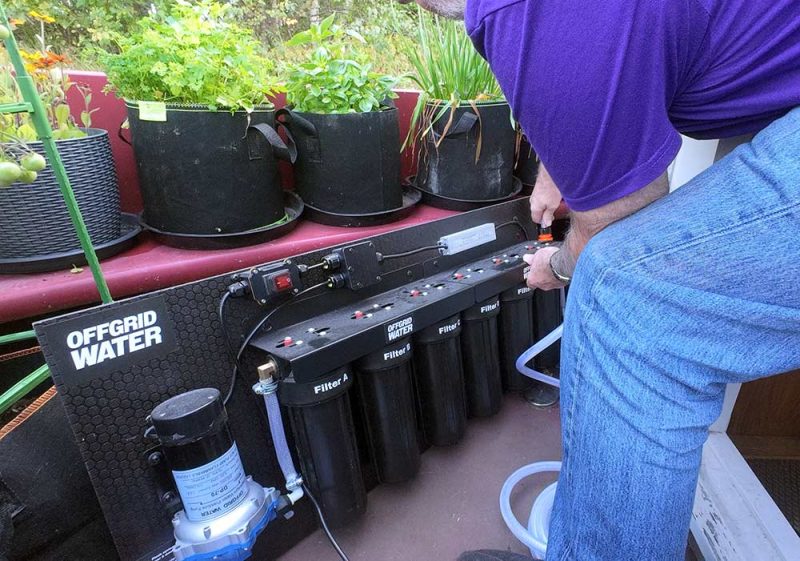Introduction
It feels like a long while since we’ve been out on the canal, but we chose a glorious day to test our new water maker finally. For the past six weeks, we have been keeping a low profile and working on numerous jobs to get our narrowboat, ‘Happidaze’, ready for constant cruising next year. A significant part of this has been the installation of our water purification system. With the solar panels and heating operational, getting the water maker and the generator running are the final big jobs on our list.

We decided to head out of the marina to test the new system. Our mooring is very close to the fuel depot, which isn’t the ideal place to draw water from the canal. We moved up to one of our favourite quiet spots, an excellent area for dog walking, to ensure we were testing with the cleanest possible canal water. In the future, we plan to avoid drawing water in areas with high boat traffic, near fuel depots, or in marinas.

Setting Up and First Tests
For the initial test of our Stage One OffGridWater water purification system, we decided to run it in the bow of the boat, surrounded by our tomato plants, just to check for any leaks or air blockages. Usually, the system is installed inside, but for this first run, an outdoor setup was more practical.

We connected the power to the pump and dropped the intake hose, with its coarse filter, into the canal to keep out larger debris. The “product water” hose, which will eventually fill our tanks, was directed back into the canal for this initial test.
A crucial detail we learned from fellow boater Steve is to keep the intake hose suspended just below the water’s surface. This prevents it from sucking up silt from the bottom of the canal or getting blocked by floating leaves and debris on the surface. In the future, we might attach a float to the hose to ensure it always sits at the perfect depth.

Leaks and Water Flow
As is often the case with new installations, we immediately spotted a small leak from one of the Jubilee clips, which was quickly tightened. We then noticed another minor leak on the UV filter. Despite these minor issues, the water was being supplied at a rate comparable to the municipal water supply in the marina, which we were very pleased with. After adding a second Jubilee clip to the filter housing, we were able to resolve the leak and proceed with testing the water quality.

Testing the Water Quality
With the system running smoothly, the next step was to test the quality of the purified water. We used a home testing kit that we bought from Amazon. This kit includes strips that test for various elements, including nitrates, chlorine, heavy metals like copper and iron, lead, and sulfates. To establish a baseline, we first took a sample of the canal water itself in a watering can, ensuring it was thoroughly rinsed beforehand.

The testing process is straightforward: dip a strip into the water for a couple of seconds and then compare the colour changes on the strip to a key on the side of the container. While these strips are a good start, they don’t test for things like E. coli. For that, you need to send samples off for expensive laboratory testing, which can cost anywhere from £70 to over £300 per test. For now, we are relying on these strips and our multi-stage filtration process.

Ensuring Water Safety
The preliminary results from the test strips showed very little difference between the municipal water from the marina and the water that had passed through our stage one filter. To be extra cautious, we decided to use an additive in our water tank. One of our viewers pointed out that both chlorine and hydrogen peroxide can corrode stainless steel tanks like ours. As an alternative, we are using effervescent tablets containing Troclosene Sodium, which slowly releases chlorine in low doses. These tablets are effective against a range of bacteria, including Legionella, cholera, E.coli, and Salmonella. We added two tablets to our 500-litre tank and let it sit for 30 minutes before drawing any water.

Reverse Osmosis for Peace of Mind
The final stage of our system is the reverse osmosis unit under the sink. After running the water through all the stages, including the newly installed ultrafilter, we have now been drinking the purified canal water for two days. We are happy to report no ill effects! The coffee tastes just like it did on our sailboat, where we also had a reverse osmosis system. A total dissolved solids (TDS) gauge on the water maker shows a reading of 9 or 10. Good drinking water is typically between 150 and 300 TDS, so our water is incredibly pure. This raises the possibility of adding a remineralisation filter in the future to replenish some of the beneficial minerals and enhance the taste.

In terms of installation, the OffGridWater system is quite literally plug-and-play. The most significant issues are cable and hose runs, but once you’ve established where to install each stage, the rest is straightforward. Don’t fall into the trap that I did: overcomplicating things. When placed in the correct location, each stage is easy to install.
Would We Recommend The OffGridWater System?
While building your own water filtration system is possible, the OffGridWater system offers a robust and well-engineered solution, particularly for those living on a boat or in other harsh environments. The pre-built units are designed with waterproof components to withstand the rigours of boat life, a feature that might be overlooked in a DIY setup.
The system is modular, consisting of three distinct stages that can be installed individually or as a complete package. This “plug-and-play” design allows users to customise their water filtration based on specific needs.
- Stage 1: This initial stage is designed to draw and filter water from sources like canals, rivers, lakes, or rainwater. It features a 7-stage filtration process and includes an integrated pump, making it a comprehensive solution for filling your water tank with water suitable for washing and other domestic uses.
- Stage 2: This stage further purifies the water from the primary tank, whether it’s from a municipal source or has already passed through Stage 1. It is designed to be installed after your water pump and employs de-ionisation, ultrafiltration, and carbon filtration to bring the water up to drinking standards. For those who consistently use reliable municipal water, Stage 2 alone may be sufficient.
- Stage 3: The most impressive component is the Stage 3 reverse osmosis unit. This compact system is highly effective at purifying water, removing a wide array of contaminants. Key features include a built-in Total Dissolved Solids (TDS) reader to monitor water quality, easily accessible membranes for maintenance, and a smart-tap with an indicator light that signals the water’s purity. Regardless of the initial water source, the Stage 3 unit is highly recommended for ensuring safe drinking water.
For complete water independence, the combination of all three stages now provides us with a limitless supply of safe drinking water. This eliminates the need for water conservation and the logistical challenges of frequent fill-ups. The convenience of having an unlimited supply of purified water for showering, washing dishes, and laundry offers a significant improvement in our quality of life.

Since completing our installation, the difference has been night and day. Gone are the days of washing up in a scant 2cm of water; we can now rinse dirty dishes right under a running tap. Showers have been transformed from a strategic “on-off-on” soaping-up dance into a luxurious experience that lasts as long as the hot water does. We’ve also used the washing machine more in the last week than we did in the entire previous month!
It’s these little comforts we had to sacrifice and grew so accustomed to living without. They became just another part of life abroad, but having them back is absolutely wonderful.
Video
Check out the video below where we go into things in more detail and show you the testing process.
If you like our content and would like to support us, we will give you ad-free access to our videos before they go live to the public, discounts in our shop, access to Jamie’s iconic full-res photographs, and supporter-only blog posts. Click our ugly mugs for more info!


